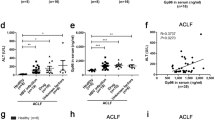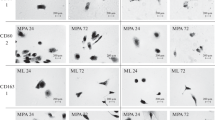Summary
To elucidate the function of the reticuloendothelial system of liver in hepatic injury, we investigated the effect of endotoxins on Superoxide anion (O -2 ) generating capacity and lysosomal enzyme activities of Kupffer cells isolated from rats treated with galactosamine (Gal N), with Gal N supplemented with polymyxin B (Polymyxin B-Gal N), with lipopolysaccharide (LPS) and from control rats. After collagenase digestion of the liver and centrifugation over metrizamide gradient, Kupffer cells were prepared by the dish adherence procedure. O -2 production by the cells was examined as chemiluminescence during phagocytosis of latex particles and Β-glucuronidase activities were analyzed. High titers of endotoxemia were detected in LPS and Gal N rats by Iimulus test, while a low endotoxemia titer was found in Polymyxin B-Gal N rats. Hepatocyte damage was found in Gal N rats, but little was recognized in LPS and Polymyxin B-Gal N rats. In the latter groups, Kupffer cells, activated by endotoxins, showed the enhancement of chemiluminescence and a release of lysosomal enzyme. Though lysosomal enzyme was released from Kupffer cells in Gal N rats, chemiluminescence was slightly suppressed in spite of the high titer of endotoxemia. These results appear to be related to the consumption of O -2 during liver injury. The functional state of Kupffer cells was thus changed by the grade of endotoxemia and hepatic injury.
Similar content being viewed by others
References
Griffin FM: Mononuclear cell phagocytic mechanisms and host defense, in “Advances in host defense mechanism” Vol. 1 Phagocytic cells, by Gallin JI and Fauci AS. Raven Press, New York, 1982, p 31
Holden HT, et al: In vitro functional activity of macrophages (Part III), in “Manual of macrophage methodology”, by Herscowitz HB, Holden HT, Bellanti JA and Ghaffar A Marcel Dekker Inc., New York, 1981, p 253
Rossi F, et al: The respiratory burst of phagocytic cells; fact and problems, in “Biochemistry and function of phagocytes”, by Rossi F and Patriarca P. Plenum Press, New York, 1982, p 283
Markert M, et al: The respiratory burst in human polymorphonuclear leukocytes stimulated by particles, in “Biochemistry and function of phagocytes”, by Rossi F and Patriarca P. Plenum Press, New York, 1982,p383
Drath DB, et al: Superoxide production by phagocytic leukocytes. J Exp Med 141: 257, 1975
Weening RS, et al: Quantitative aspects of the production of Superoxide radical by phagocytizing human granulocytes. J Lab Clin Med 85: 245, 1975
Johnston RB, et al: Increased Superoxide anion production by immunologically activated and chemically elicited macrophages. J Fxp Med 148: 115, 1978
Schleupner CJ, et al: Peritoneal macrophage activation indicated by enhance chemiluminescence. Infect Immun 21: 886, 1978
Pabst MJ, et al: Increased production of Superoxide anion by macrophages exposed in vitro to muramyl dipeptide or lipopolysaccharide. J Exp Med 151: 101, 1980
Weiss SJ, et al: Oxidative mechanism of monocytemediated cytotoxicity. Proc Natl Acad Sci 77: 584, 1980
Weiss SJ, et al: Monocyte and granulocyte-mediated tumor cell destruction. J Clin Invest 69: 255, 1982
Locksley RM, et al: Role for endogenous and acquired peroxidase in the toxoplasmacidal activity of murine and human mononuclear phagocytes. J Clin Invest 69: 1099, 1982
Klebanoff SJ: Oxygen-dependent cytotoxic mechanisms of phagocytes, in “Advances in host defense mechanism” Vol. 1 Phagocytic cells, by Gallin JI and Fauci AS. Raven Press, New York, 1982, p 111
Allen: Chemiluminescence and the study of phagocyte redox metabolism, in “Biochemistry and function of phagocytes”, by Rossi F and Patriarca P. Plenum Press, New York, 1982, p 411
De Sole P, et al: Resting and stimulated chemiluminescence of polymorphonuclear leukocytes; a clinical approach, in “Biochemistry and function of phagocytes”, by Rossi F and Patriarca P. Plenum Press, New York, 1982, p 591
Liehr H, et al: Endotoxin in liver disease, in “Progress in liver disease” Vol. 6, by Popper H and Schaffner F. Grune and Stratton, New York, 1979, p 313
Ruiter DJ, et al: Some cell biological and pathological aspects of the endotoxin uptake by the liver, in “The reticuloendothelial system and the pathogenesis of liver disease”, by Liehr H and Grun MG. Elsevier, North Holland, 1980, p 267
Ferluga J, et al: Role of mononuclear infiltrating cells in pathogenesis of hepatitis. Lancet 1: 610, 1978
Grun MG, et al: Biological significance of altered von Kupffer cell function in experimental liver disease, in “Kupffer cells and other liver sinusoidal cells”, by Wisse E and Knook DL. Elsevier, North Holland, 1977,p 437
Liehr H: Biological significance of RES function in galactosamine hepatitis, in “The reticuloendothelial system and the pathogenesis of liver disease”, by Liehr H and Grun MG. Elsevier, North Holland, 1980, p 185
Tanner A, et al: Proteolytic enzyme released by liver macrophages may promote hepatic injury in a rat model of hepatic damage. Gastroenterology 80: 647, 1981
Tanner AR, et al: The influence of endotoxin in vitro on hepatic macrophage lysosomal enzyme release in different rat models of hepatic injury. Liver 3: 151, 1983
Gut JP, et al: Further indications of the role played by enteric endotoxins in the pathogenesis of FV 3 hepatitis in mice and rats, in “Sinusoidal liver cells”, by Knook DL and Wisse E. Elsevier Biomedical Press, Amsterdam, 1982, p 475
Lope J, et al: Electron microscopy of effect of polymyxin on Escherichia coli lipopolysaccharide. J Bacteriol 100: 1128, 1969
Broitman SA, et al: Influence of neomycin and ingested endotoxin in the pathogenesis of choline deficiency cirrhosis in the adult rat. J Exp Med 119: 633, 1964
Nolan JP, et al: Endotoxin and the liver. III. Modification of acute carbon tetrachloride injury by polymyxin Ban antiendotoxin. Gastroenterology 75: 445, 1978
Nolan JP: Endotoxin, reticuloendothelial function, and liver injury. Hepatology 1: 458, 1981
Shiratori Y, et al: Kupffer cells inhibit the lymphoproliferative response to antigenic stimulation by rat hepatocytes. Scand J Gastroenterol 18: 411, 1982
Chordirker WB, et al: Isolation of human PMN leukocytes and granules; observations on early blood dilution and on heparin. J Lab Clin Med 71: 9, 1968
Gianetto R, et al: Tissue fractionation studies. IV. Comparative study of the acid phosphatase, Βglucuronidase and cathepsin by rat liver particles. Biochem J 59:453, 1955
Fishmann WH: Β-Glucuronidase, in “Methods of enzymatic analysis”, by Bergmeyer HU. Academic Press, New York, 1974, p 929
Walker EB, et al: Macrophage chemiluminescence, in “Manual of macrophage methology”, by Herscowitz HB, Holden HT, Bellanti JA and Ghaffar A. Marcel Dekker Inc., New York, 1981, p 389
Van Dyke K, et al: Luminol dependent chemiluminescence analysis of cellular and humonal defects using a chemglo photometer. Microchemical J 22: 463, 1977
Berry MN, et al: High-yield preparation of isolated rat liver parenchymal cells. A biochemical and fine structural study. J Cell Biol 43: 506, 1969
Munthe-kaas AC, et al: Distribution of lysosomal enzymes in different type of rat liver cells. Exp Cell Res 99: 146, 1976
Alexander P, et al: Endotoxin and double stranded RNA render macrophages cytotoxic. Nature New Biology 232: 76, 1971
Hibbs JB: Heterocytolysis by macrophages activated by bacillus Calmette-Guérin; lysosome exocytosis into tumor cells. Science 184: 468, 1974
Hirata K, et al: Effect of endotoxin on rat liver; analysis of acid phosphatase isozymes in the liver of normal and endotoxin-treated rats. Lab Invest 43: 165, 1980
Weissman G, et al: Studies on lysosomes. I. The effect of endotoxin, endotoxin tolerance, and cortisone on the release of acid hydrolases from a granular fraction of rabbit liver. J Exp Med 116: 433, 1963
Rubin R, et al: Mechanisms of the killing of cultured hepatocytes by hydrogen peroxide. Arch Biochem Biophy 228:450, 1984
Author information
Authors and Affiliations
Rights and permissions
About this article
Cite this article
Shiratori, Y., Takikawa, H., Kawase, T. et al. Superoxide anion generating capacity and lysosomal enzyme activities of Kupffer cells in galactosamine induced hepatitis. Gastroenterol Jpn 21, 135–144 (1986). https://doi.org/10.1007/BF02774831
Received:
Accepted:
Issue Date:
DOI: https://doi.org/10.1007/BF02774831




